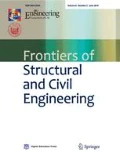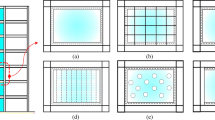Abstract
According to the current seismic design codes of bridges in China, cable-stayed bridges have been usually required to remain elastic even subjected to strong earthquakes. However, the possibilities of pylon plastic behavior were revealed in recent earthquake damages. The lack of due diligence in the nonlinear seismic behavior of the pylon has caused a blurry understanding about the seismic performance of such widely built though less strong earthquake experienced structures. In light of this point, a 1/20 scaled concrete pylon model which from a typical medium span cable-stayed bridge was designed and tested on the shaking table longitudinally. The dynamic response and seismic behavior of the pylon were measured, evaluated and compared to reveal its vulnerable parts and nonlinear seismic performance. The results show that most parts of the concrete pylon remain elastic even under very strong excitations, which means a sufficient safety margin for current pylon longitudinal design. The most vulnerable parts of the pylon appeared first at the pylon bottom region, cracks opening and closing at the pylon bottom were observed during the test, and then extended to the lower column and middle column around the lower strut.
Similar content being viewed by others
References
Ministry of Transportation of the People’s Republic of China. Guidelines for Seismic Design of Highway Bridges (GSDHB), JTG/ T B02-01-2008. Beijing: China Communications Press, 2008 (in Chinese)
Chang K C, Mo Y L, Chen C C, Lai L C, Chou C C. Lessons learned from the damaged Chi-Lu cable-stayed bridge. Journal of Bridge Engineering, 2004, 9(4): 343–352
Liao W I, Loh C H, Lee B H. Comparison of dynamic response of isolated and non-isolated continuous girder bridges subjected to near-fault ground motions. Engineering Structures, 2004, 26(14): 2173–2183
Park S W, Ghasemi H, Shen J, Somerville P G, YenWP, Yashinsky M. Simulation of the seismic performance of the Bolu viaduct subjected to near-fault ground motions. Earthquake Engineering & Structural Dynamics, 2004, 33(13): 1249–1270
He W L, Agrawal A K, Mahmoud K. Control of seismically excited cable-stayed bridge using resetting semi active stiffness dampers. Journal of Bridge Engineering, 2001, 6(6): 376–384
Vader T S, McDaniel C C. Influence of dampers on seismic response of cable-supported bridge towers. Journal of Bridge Engineering, 2007, 12(3): 373–379
Miyamoto H K, Gilani A S J, Wada A, Ariyaratana C. Limit states and failure mechanisms of viscous dampers and the implications for large earthquakes, 2010, 39(11): 1279–1297
Ribakov Y. Using viscous and variable friction dampers for improving structural seismic response. Structural Design of Tall and Special Buildings, 2011, 20(5): 579–593
Camara A, Astiz M A. Pushover analysis for the seismic response prediction of cable-stayed bridges under multi-directional excitation. Engineering Structures, 2012, 41: 444–455
Okamoto K, Nakamura S. Static and seismic studies on steel/concrete hybrid towers for multi-span cable-stayed bridges. Journal of Constructional Steel Research, 2011, 67(2): 203–210
Thai H T, Kim S E. Second-order inelastic analysis of cable-stayed bridges. Finite Elements in Analysis and Design, 2012, 53: 48–55
Garevski M A, Brownjohn J M W, Blakeborough A, Severn R T. Resonance-search tests on a small-scale model of a cable-stayed bridge. Engineering Structures, 1991, 13(1): 59–66
Caetano E, Cunha A, Taylor C A. Investigation of dynamic cabledeck interaction in a physical model of a cable-stayed bridge. Part I: Modal analysis. Earthquake Engineering and Structure Engineering, 2000, 29(4): 481–498
Caetano E, Cunha A, Taylor C A. Investigation of dynamic cabledeck interaction in a physical model of a cable-stayed bridge. Part II: Seismic response. Earthquake Engineering and Structure Engineering, 2000, 29(4): 499–521
Wang J J, Zhang X T, Fan L C, Wang Z Q, Chen H, Zhou M, Li S Y, Mo H L, Ni Z J. A brief introduction to the shaking-table test of Liede Bridge. In: Proceedings of 4th PRC-USWorkshop on Seismic Analysis and Design of Special Bridges, Advancing Bridge Technologies in Research, Design, Construction and Preservation. Chongqing, 2006, 187–198
Wang R, Xu Y, Li J. Transverse seismic behavior studies of a typical medium span cable-stayed bridge model with two concrete towers. Journal of Earthquake Engineering, 2016, 21(1): 151–168
Xu Y, Wang R, Li J. Experimental verification of a cable-stayed bridge model using passive energy dissipation devices. Journal of Bridge Engineering, 2016, 21(12): 04016092
Harris H G, Sabnis G M. Structural Modeling and Experimental and Experimental Techniques. 2nd ed. Boca Raton: CRC Press, 1999
Xiang H, Li R, Yang C. Simplified seismic calculation of cablestayed bridge with suspension system. Structural Engineers, 1986, 1: 64–69 (in Chinese)
Chopra A K. Dynamic of Structures: Theory and Applications to Earthquake Engineering. Upper Saddle River: Prentice Hall, 2006
Acknowledgements
This research was finically supported by the National Natural Science Foundation of China (Grant No. 51478338).
Author information
Authors and Affiliations
Corresponding author
Rights and permissions
About this article
Cite this article
Xu, Y., Zeng, S., Duan, X. et al. Seismic experimental study on a concrete pylon from a typical medium span cable-stayed bridge. Front. Struct. Civ. Eng. 12, 401–411 (2018). https://doi.org/10.1007/s11709-018-0464-8
Received:
Accepted:
Published:
Issue Date:
DOI: https://doi.org/10.1007/s11709-018-0464-8




